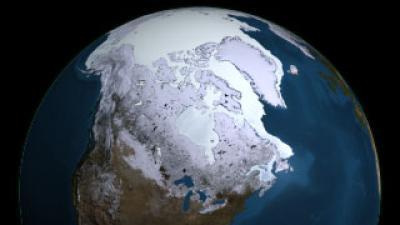New research to rebuild the ice level on the sea between Greenland and Svalbard from the 13th century to the present shows that there has never been a low amount of sea ice. The research results of Niels Bohr are published in a scientific paper called Climate Dynamics.
There are not always satellite images or climate recording tools since the 13th century, but nature still has its own way of storing its information in ice cores and birth rings. the head of the tree; At the same time, humanity has recorded a lot of things - for example, related indicators in ship logs or port records. Rearranging all this data, you can get a picture of sea ice change over time.
Modern research and historical figures
'We have combined climate information found in ice cores taken from an ice cap in Svalbard and in the tree's growth cycle in Finland, these numbers tell us what climate changes have taken place, ' Aslak Grinsted, geophysicist of the Center for Ice and Climate Research at the Niels Bohr Institute, University of Copenhagen, explains.
In order to determine how many sea ice sheets were used in the past, researchers have to recall the data recorded in the logbooks of ships that fishermen and whale hunters used to record information. believe in your schedule. These diaries are accurate and date back to the 16th century. They include what sea ice information appears on the geographic location. Another source of data about the ice is the records of the ports in Iceland, where people have always recorded the severity of winter since the 18th century to the present.
 Never before has the amount of ice in the sea between Svalbard and Greenland in the last 800 years been as low as it is now. (Photo: NASA / GSFC)
Never before has the amount of ice in the sea between Svalbard and Greenland in the last 800 years been as low as it is now. (Photo: NASA / GSFC)
By combining climate change data with actual record numbers of ice distribution, researchers have been able to recreate the amount of sea ice at times since the 13th century to the present. Although the 13th century is when the climate is very hot, calculations show that there has never been less sea ice as in the 20th century.
The mid-17th century also saw a marked decrease in ice, but the decline only lasted for a very short time. The most heavily covered ice was in the years 1700 - 1800, the period called the Little Ice Age.
'There is a clear change in the amount of ice covered at the beginning of the 20th century,' explained Aslak Grinsted. He said the cover tape had decreased by 300,000 km2 in 10 years 1910-1920. Thus, you can see that there has always been a decline over time, but in recent years, we have witnessed years of low record ice.
'We are witnessing a shrinking sea ice, leaving only a handful of people never seen in the past 800 years,' concluded Aslak Grinsted.
Refer:
Macias Fauria et al.Unprecedented low twentieth century winter sea ice in the Western Nordic Seas since AD 1200. Climate Dynamics, 2009;DOI: 10.1007 / s00382-009-0610-z
 Surprised: Fish that live in the dark ocean still see colors
Surprised: Fish that live in the dark ocean still see colors Japan suddenly caught the creature that caused the earthquake in the legend
Japan suddenly caught the creature that caused the earthquake in the legend A series of gray whale carcasses washed ashore on California's coast
A series of gray whale carcasses washed ashore on California's coast Compare the size of shark species in the world
Compare the size of shark species in the world